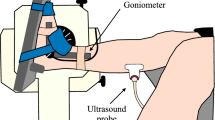Abstract
Background
The aim of this study was to evaluate whether aging affects (1) the sensation of joint stiffness after lengthening contractions (LCs); (2) passive resistive torque (PRT) of the ankle joint; (3) and the connectin (titin) isoform composition in the medial gastrocnemius (MG) muscle.
Methods
Anesthetized young (9 weeks) and adult (35 weeks) Wistar rats (n = 6 per group) were used in the present study. A single bout of LCs was performed on the MG muscle with a combination of electrically induced tetanic contractions via a skin electrode and simultaneous forced dorsiflexion of the ankle joint (angular velocity 15°/s, 0°–45°). Static PRT of the ankle joint (at 30° and 45°) was measured to evaluate joint stiffness. These parameters were measured until 10 days after treatment. The connectin isoform was measured as muscle extensibility employing low-porosity 2% polyacrylamide gel electrophoresis.
Results
The averaged static PRT was significantly higher in adult rats than in young rats. Connectin isoform analysis revealed that the adult group contained larger amounts of β-connectin than did the young rats. After the LCs, static PRT of the ankle joint gradually increased until day 4 in the young group, whereas the adult group did not show a significant change during the experimental period.
Conclusions
We concluded that (1) joint stiffness of adult rats is greater than in young rats, similar to human studies; (2) the increased joint stiffness may be due to connectin isoform composition; and (3) joint stiffness after MG muscle LCs is more apparent in young rats.
Similar content being viewed by others
References
Grimston SK, Nigg BM, Hanley DA, Engsberg JR. Differences in ankle joint complex range of motion as a function of age. Foot Ankle 1993;14:215–222.
Kuhlman KA. Cervical range of motion in the elderly. Arch Phys Med Rehabil 1993;74:1071–1079.
Nigg BM, Fisher V, Allinger TL, Ronsky JR, Engsberg JR. Range of motion of the foot as a function of age. Foot Ankle 1992;13:336–343.
Gajdosik RL. Passive extensibility of skeletal muscle: review of the literature with clinical implications. Clin Biomech (Bristol, Avon) 2001;16:87–101.
Porter MM, Vandervoort AA, Kramer JF. Eccentric peak torque of the plantar and dorsiflexors is maintained in older women. J Gerontol A Biol Sci Med Sci 1997;52:B125–B131.
Vandervoort AA, Chesworth BM, Cunningham DA, Paterson DH, Rechnitzer PA, Koval JJ. Age and sex effects on mobility of the human ankle. J Gerontol 1992;7:M17–M21.
Chesworth BM, Vandervoort AA. Age and passive ankle stiffness in healthy women. Phys Ther 1989;69:217–224.
Gajdosik RL, Vander Linden DW, Linden Williams AK. Influence of age on concentric isokinetic torque and passive extensibility variables of the calf muscles of women. Eur J Appl Physiol Occup Physiol 1996;74:279–286.
Gajdosik RL, Vander Linden DW, McNair PJ, Riggin TJ, Albertson JS, Mattick DJ, et al. Viscoelastic properties of short calf muscle-tendon units of older women: effects of slow and fast passive dorsiflexion stretches in vivo. Eur J Appl Physiol 2005;95:131–139.
Chleboun GS, Howell JN, Conatser RR, Giesey JJ. Relationship between muscle swelling and stiffness after eccentric exercise. Med Sci Sports Exerc 1998;30:529–535.
Nosaka K, Clarkson PM. Muscle damage following repeated bouts of high force eccentric exercise. Med Sci Sports Exerc 1995;27:1263–1269.
Brooks SV, Faulkner JA. Contraction-induced injury: recovery of skeletal muscles in young and old mice. Am J Physiol 1990;258:C436–C442.
Schneider BS, Fine JP, Tiidus PM. Indices of leukocyte infiltration and muscle recovery after eccentric contraction-induced injury in young and adult male mice. Orthop Nurs 2005;24:399–405.
Gillette PD, Fell RD. Passive tension in rat hindlimb during suspension unloading and recovery: muscle/joint contributions. J Appl Physiol 1996;81:724–730.
Tatsumi R, Hattori A. Detection of giant myofibrillar proteins connectin and nebulin by electrophoresis in 2% polyacrylamide slab gels strengthened with agarose. Anal Biochem 1995;224:28–31.
Neagoe C, Opitz CA, Makarenko I, Linke WA. Gigantic variety: expression patterns of titin isoforms in striated muscles and consequences for myofibrillar passive stiffness. J Muscle Res Cell Motil 2003;24:175–189.
Warren CM, Krzesinski PR, Greaser ML. Vertical agarose gel electrophoresis and electroblotting of high-molecular-weight proteins. Electrophoresis 2003;24:1695–1702.
Nakazato K, Song H, Waga T. Dietary apple polyphenols enhance gastrocnemius function in Wistar rats. Med Sci Sports Exerc 2007;39:934–940.
Ochi E, Nakazato K, Ishii N. Effects of eccentric exercise on joint stiffness and muscle connectin (titin) isoform in the rat hindlimb. J Physiol Sci 2007;57:1–6.
Clarkson PM, Nosaka K, Braun B. Muscle function after exerciseinduced muscle damage and rapid adaptation. Med Sci Sports Exerc 1992;24:512–520.
Stauber WT, Clarkson PM, Fritz VK, Evans WJ. Extracellular matrix disruption and pain after eccentric muscle action. J Appl Physiol 1990;69:868–874.
Howell JN, Chleboun G, Conatser R. Muscle stiffness, strength loss, swelling and soreness following exercise-induced injury in humans. J Physiol 1993;464:183–196.
Hamada K, Vannier E, Sacheck JM, Witsell AL, Roubenoff R. Senescence of human skeletal muscle impairs the local inflammatory cytokine response to acute eccentric exercise. FASEB J 2005;19:264–266.
Funatsu T, Higuchi H, Ishiwata S. Elastic filaments in skeletal muscle revealed by selective removal of thin filaments with plasma gelsolin. J Cell Biol 1990;110:53–62.
Granzier HL, Labeit S. Titin and its associated proteins: the third myofilament system of the sarcomere. Adv Protein Chem 2005;71:89–119.
Lindstedt SL, Reich TE, Keim P, LaStayo PC. Do muscles function as adaptable locomotor springs? J Exp Biol 2002;205:2211–2216.
LeWinter MM. Titin isoforms in heart failure: are there benefits to supersizing? Circulation 2004;110:109–111.
Thompson JL, Balog EM, Fitts RH, Riley DA. Five myofibrillar lesion types in eccentrically challenged, unloaded rat adductor longus muscle — a test model. Anat Rec 1999;254:39–52.
Prado LG, Makarenko I, Andresen C, Krüger M, Opitz CA, Linke WA. Isoform diversity of giant proteins in relation to passive and active contractile properties of rabbit skeletal muscles. J Gen Physiol 2005;126:461–480.
Author information
Authors and Affiliations
About this article
Cite this article
Ochi, E., Nakazato, K., Song, H. et al. Aging effects on passive resistive torque in the rat ankle joint after lengthening contractions. J Orthop Sci 13, 218–224 (2008). https://doi.org/10.1007/s00776-008-1216-8
Received:
Accepted:
Published:
Issue Date:
DOI: https://doi.org/10.1007/s00776-008-1216-8




